Matcha
Green Tea Delights: Easy Matcha Recipe Essentials

Welcome to Green Tea Delights: Easy Matcha Recipe Essentials! In this guide, we will take you on a journey to master the art of matcha preparation.
Get ready to indulge in the world of matcha, a vibrant green tea powder that offers a plethora of health benefits and a unique flavor profile.
We will teach you how to choose the right matcha powder, introduce you to essential tools for matcha preparation, and share simple recipes for matcha lattes, smoothies, and baked goods.
Whether you’re craving a savory matcha dish or a matcha-infused dessert, we’ve got you covered.

Join us as we explore traditional matcha ceremonies and unlock the secrets to creating delicious matcha delights.
Let’s embark on this exciting matcha adventure together!
Key Takeaways
- Matcha is rich in antioxidants called catechins, which help protect against chronic diseases.
- The unique amino acid L-theanine in matcha promotes relaxation and mental clarity.
- Matcha aids in detoxification and weight management.
- Regular consumption of matcha enhances overall well-being.
Health Benefits of Matcha
We have discovered the numerous health benefits of matcha through extensive research and personal experience.
Matcha, a vibrant green powdered tea, is renowned for its exceptional antioxidant properties. These antioxidants, known as catechins, help protect the body against harmful free radicals, reducing the risk of chronic diseases such as heart disease and cancer.
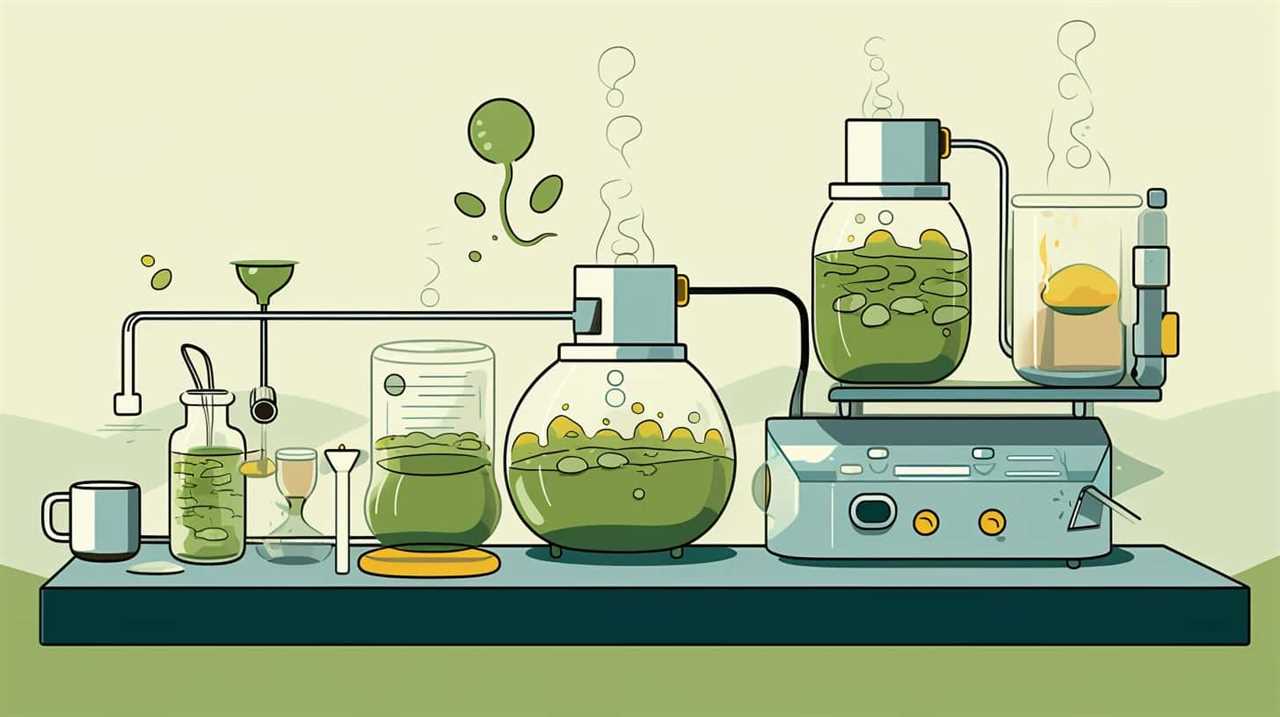
Matcha also contains a unique amino acid called L-theanine, which promotes relaxation and mental clarity without causing drowsiness.
Additionally, matcha is a natural detoxifier, aiding in the removal of toxins from the body. It boosts metabolism and helps in weight management by increasing fat oxidation.
Furthermore, matcha provides a steady release of energy, unlike the jittery effects of caffeine found in coffee.
Indulging in a daily cup of matcha can truly enhance your overall well-being.
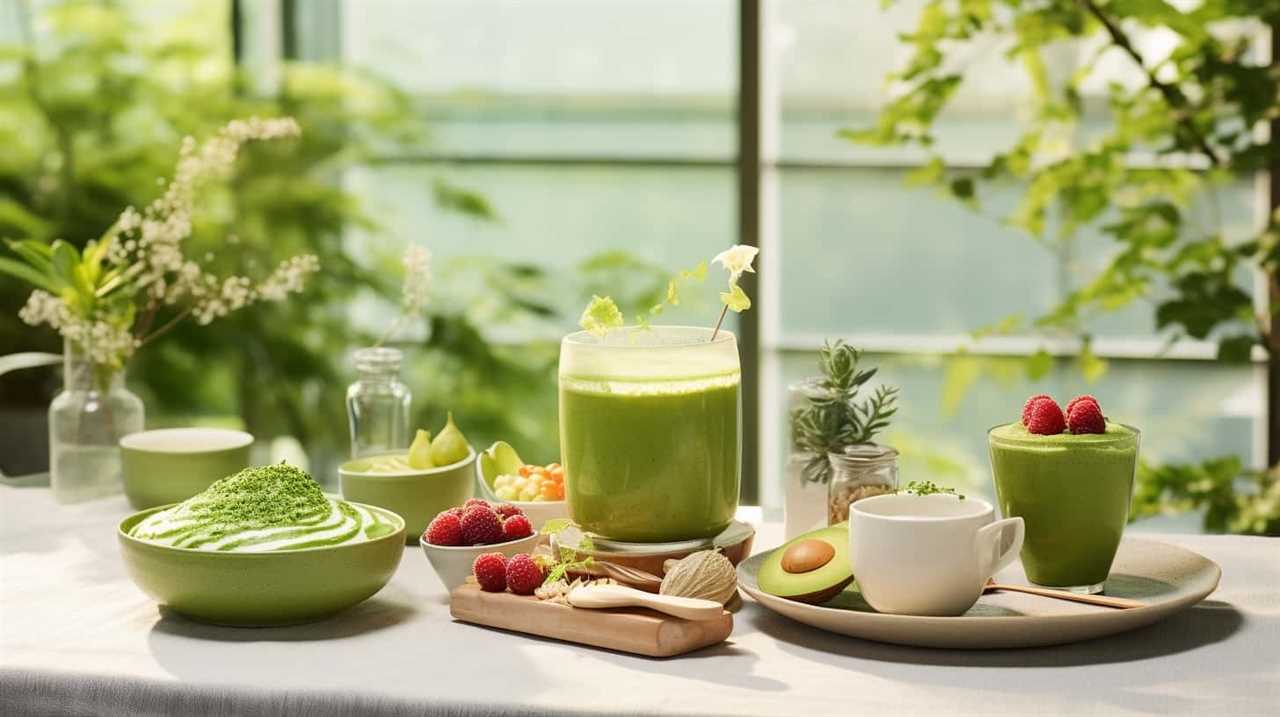
Choosing the Right Matcha Powder
When it comes to choosing the right matcha powder, there are a few key points to consider.
First, quality versus price is a crucial factor. While high-quality matcha may be more expensive, it often delivers a superior taste and aroma.
Second, deciding between culinary and ceremonial grade matcha is essential. Culinary grade is ideal for cooking and baking, while ceremonial grade is best for traditional tea ceremonies.
Quality Vs. Price
To find the perfect matcha powder, it’s important to consider the quality and price. When it comes to price comparison, it’s essential to remember that a higher price doesn’t always guarantee better quality. While premium matcha powders tend to be more expensive, there are also affordable options that can still deliver a satisfactory taste and aroma. It’s all about finding the right balance between quality and price.

In addition to price, sustainability practices should also be taken into account. Look for matcha brands that prioritize ethical sourcing and production methods. This means choosing companies that support organic farming, fair trade practices, and environmentally friendly packaging. By choosing matcha powder that’s produced sustainably, you can enjoy your cup of tea with the knowledge that you’re supporting a greener and more responsible industry.
Culinary or Ceremonial?
As we explore the topic of choosing the right matcha powder, it’s important to consider whether you’re looking for a culinary or ceremonial grade.
Culinary grade matcha is ideal for cooking and baking, while ceremonial grade matcha is used for traditional tea ceremonies.
Culinary grade matcha has a stronger flavor and a slightly bitter taste, making it perfect for adding to smoothies, desserts, and savory dishes.

On the other hand, ceremonial grade matcha is milder and has a smoother taste, making it ideal for drinking as a traditional tea.
When it comes to the health benefits, both culinary and ceremonial grade matcha offer numerous advantages, including antioxidants and amino acids.
However, if you’re looking for matcha specifically for its medicinal properties, you may want to consider other teas that are specifically formulated for therapeutic purposes.
Essential Tools for Matcha Preparation
We rely on essential tools such as a bamboo whisk, a ceramic bowl, and a fine mesh strainer for preparing matcha. These tools are crucial in achieving the perfect matcha consistency and flavor.
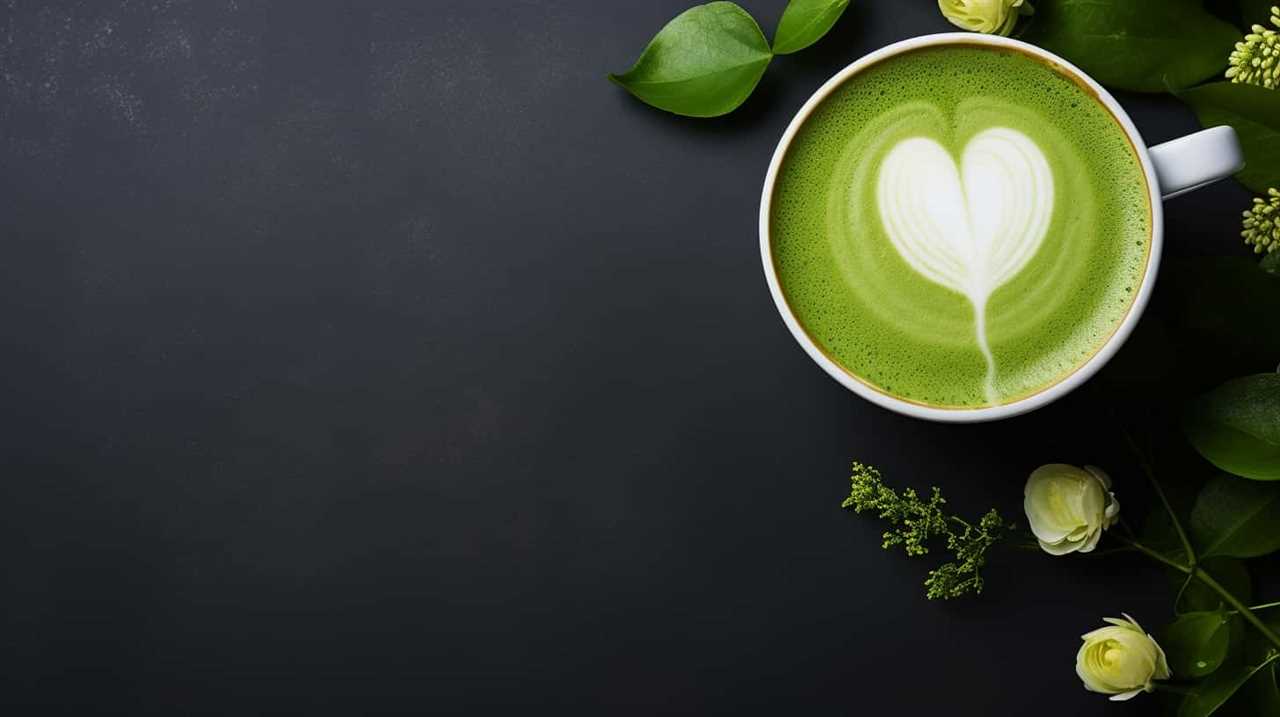
Here are five essential tools for matcha preparation:
- Matcha Whisk: This traditional bamboo whisk, known as a ‘chasen,’ is used to whisk the matcha powder into a frothy and smooth consistency. Its delicate bristles help to break up any clumps and create a velvety texture.
- Matcha Bowl: A ceramic matcha bowl, or ‘chawan,’ is specifically designed for whisking and serving matcha. Its wide shape allows for easy whisking and its high sides prevent any splattering.
- Fine Mesh Strainer: A fine mesh strainer is used to sift the matcha powder, ensuring a smooth and lump-free mixture. This step is essential for achieving a silky texture.
- Bamboo Scoop: Also known as a ‘chashaku,’ this bamboo scoop is used to measure and transfer the matcha powder into the bowl. Its curved shape allows for easy scooping and precise measurement.
- Matcha Whisk Holder: After use, the matcha whisk needs to be dried properly to maintain its shape. A matcha whisk holder, or ‘chasen kusenaoshi,’ helps to air-dry the whisk and prolong its lifespan.
With these essential tools in hand, you’ll be well-equipped to create a delightful cup of matcha that showcases the true flavor and beauty of this beloved green tea.
Simple Matcha Latte Recipe
Now, let’s explore a simple matcha latte recipe that we make quite often. Matcha lattes are a delicious and comforting way to enjoy the unique flavor of matcha while also reaping its health benefits. To make a basic matcha latte, you will need the following ingredients:
| Ingredients | Measurements |
|---|---|
| Matcha powder | 1 teaspoon |
| Hot water | 2 ounces |
| Milk (dairy or non-dairy) | 8 ounces |
| Sweetener (optional) | To taste |
To prepare the latte, whisk the matcha powder and hot water together until smooth and frothy. Then, heat the milk and sweeten it to your liking. Pour the matcha mixture into a cup, followed by the hot milk. Stir well and enjoy!

For those looking for matcha latte alternatives, you can try using different types of milk such as almond, oat, or coconut milk. Additionally, you can experiment with different sweeteners like honey or maple syrup to suit your taste preferences.
Before we move on to matcha smoothie variations, let’s briefly touch on the history of matcha production. Matcha has a long and rich history, dating back to ancient China and later being perfected by the Japanese. Today, Japan is renowned for its high-quality matcha, which is carefully shade-grown and stone-ground to produce a vibrant green powder.
With our simple matcha latte recipe in hand and a bit of knowledge about matcha’s origins, we can now explore the world of matcha smoothie variations.
Matcha Smoothie Variations
Let’s explore some delightful variations of matcha smoothies. Matcha smoothies not only provide a refreshing and tasty way to enjoy your daily dose of matcha, but they also offer numerous health benefits.
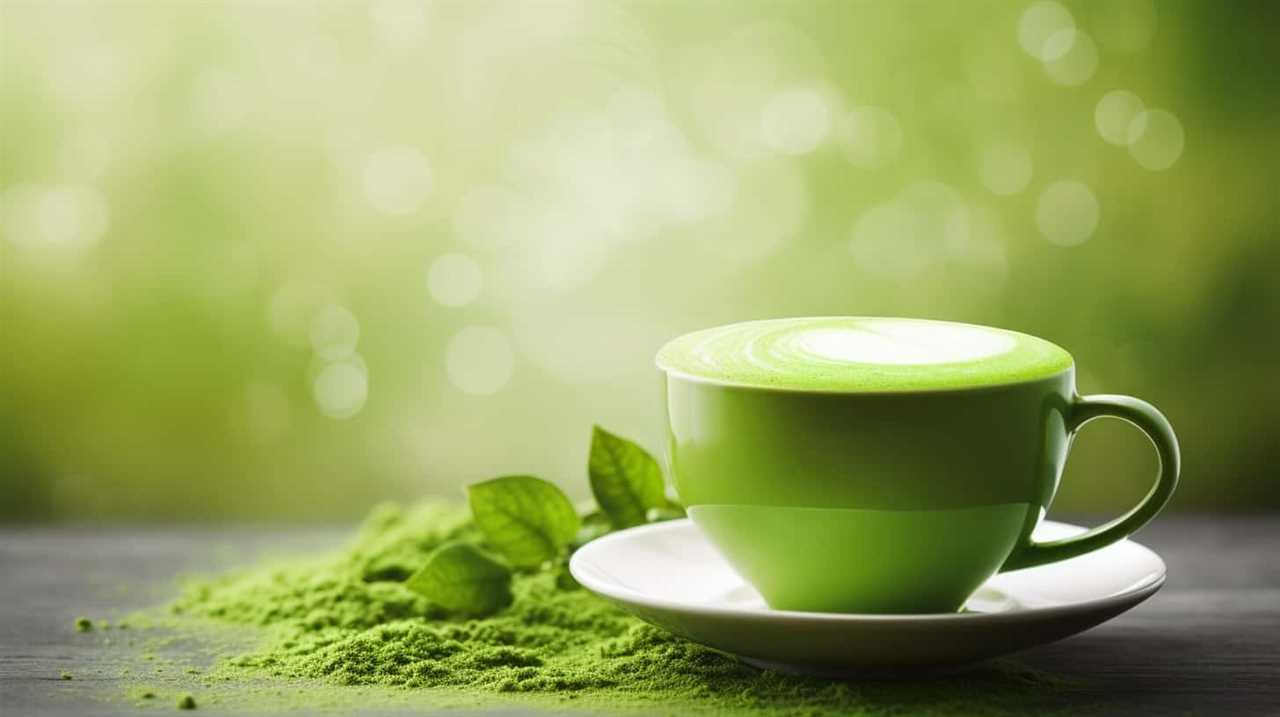
Here are five creative matcha smoothie recipes that you can try:
- Tropical Matcha Smoothie: Blend together frozen pineapple chunks, coconut milk, banana, spinach, and a teaspoon of matcha powder for a tropical twist.
- Berry Blast Matcha Smoothie: Combine frozen berries, almond milk, Greek yogurt, honey, and a scoop of matcha powder for a burst of antioxidant-rich flavors.
- Peanut Butter Matcha Smoothie: Blend together almond milk, frozen banana, peanut butter, a touch of honey, and matcha powder for a creamy and protein-packed treat.
- Mango Madness Matcha Smoothie: Blend frozen mango chunks, orange juice, Greek yogurt, honey, and a teaspoon of matcha powder for a fruity and invigorating smoothie.
- Chocolate Matcha Smoothie: Create a decadent blend by combining almond milk, cocoa powder, frozen banana, a scoop of matcha powder, and a drizzle of maple syrup.
These matcha smoothie variations not only provide a delightful taste, but also give you the added benefits of matcha’s antioxidants, natural energy boost, and potential metabolism support.
Get creative and enjoy the healthful delights of matcha!
Baking With Matcha: Easy Recipes
For the baking enthusiasts out there, there are plenty of easy recipes that incorporate matcha into delicious treats.
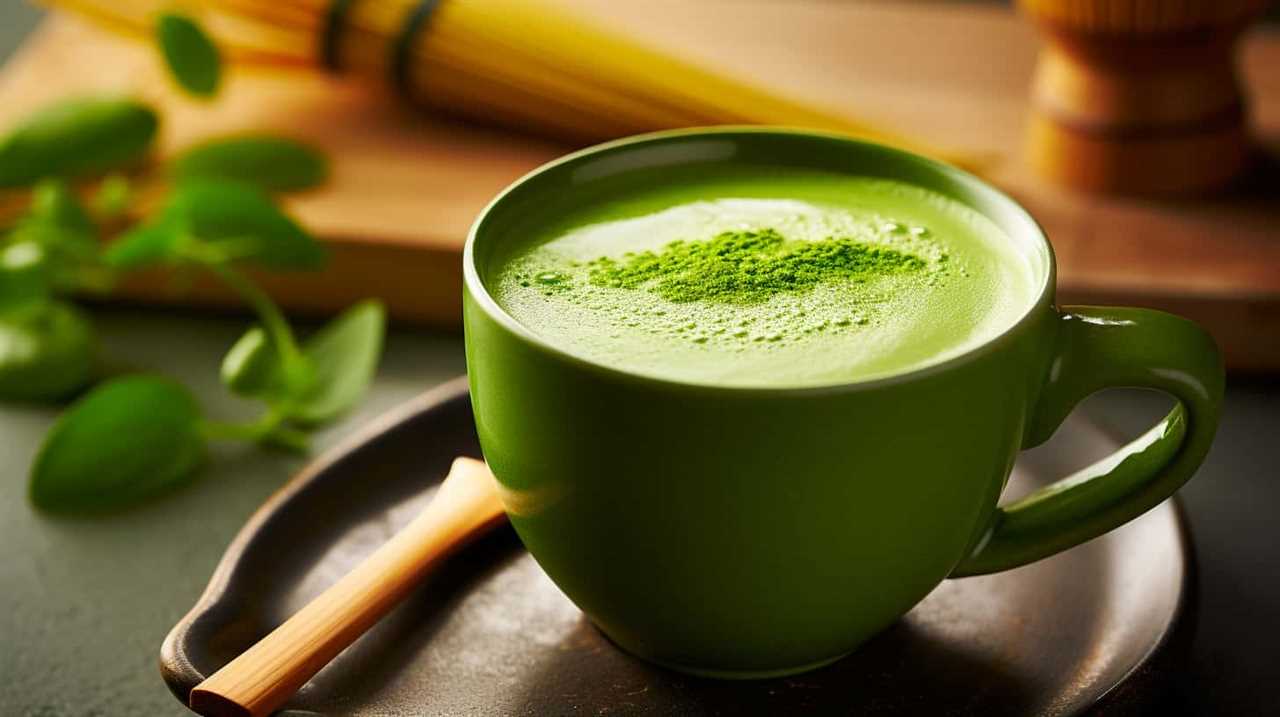
Matcha ice cream is a popular choice, with its vibrant green color and rich, earthy flavor. To make this refreshing dessert, simply mix matcha powder with vanilla ice cream base and freeze it until firm.
Another delightful option is matcha cookies. These sweet treats are made by combining matcha powder with butter, sugar, flour, and other ingredients to create a dough that’s then baked to perfection. The result is a batch of cookies with a unique, slightly bitter taste and a beautiful green hue.
Now that we’ve explored the world of matcha in baking, let’s move on to the next section about savory matcha dishes for every meal.
Savory Matcha Dishes for Every Meal
We enjoy incorporating matcha into savory dishes for every meal. Here are some delightful ways to savor the unique flavors of matcha in your breakfast, lunch, and dinner:
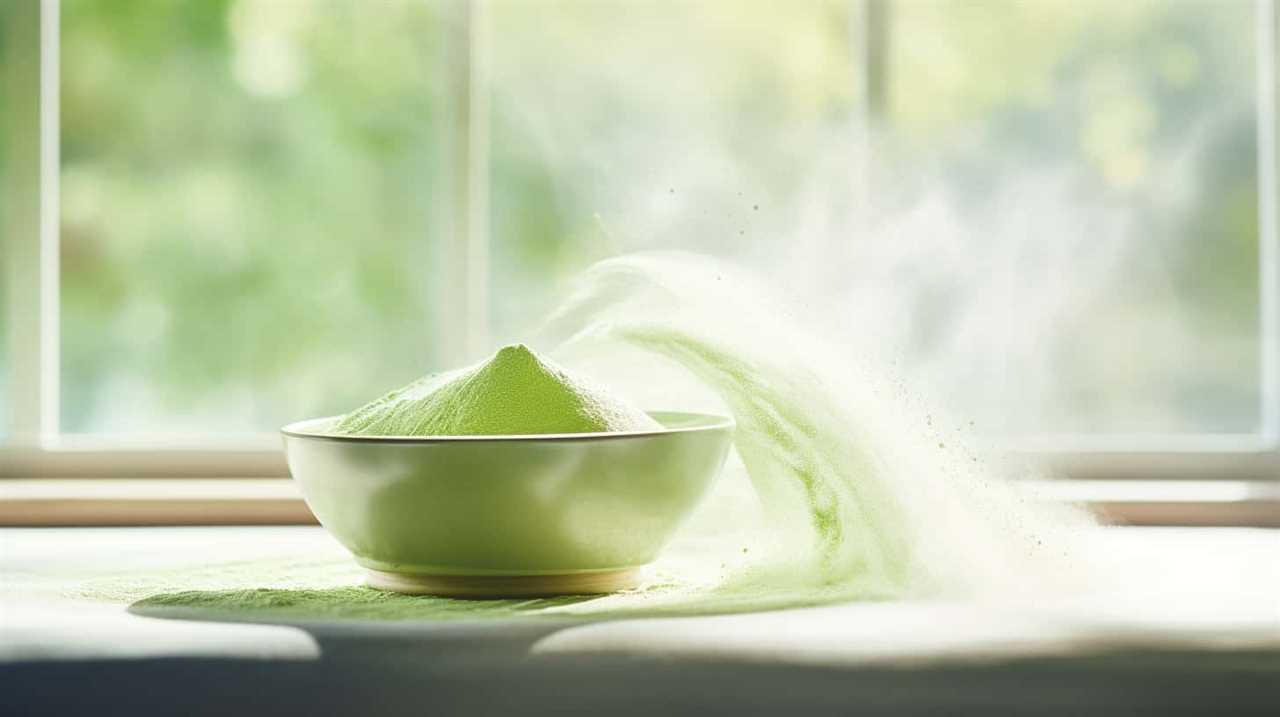
- Savory Matcha Pancakes: Start your day with a stack of fluffy pancakes infused with the earthy goodness of matcha. Top them with a dollop of creamy avocado spread for a perfect balance of flavors.
- Matcha Infused Pasta Dishes: Elevate your pasta game by adding a touch of matcha to your favorite pasta dishes. The vibrant green hue and delicate taste of matcha will give your pasta a unique twist.
- Matcha Avocado Toast: Upgrade your classic avocado toast by spreading a creamy layer of matcha-infused avocado on your favorite bread. The combination of creamy avocado and earthy matcha is simply irresistible.
- Matcha Sushi Rolls: Add a pop of color and flavor to your sushi rolls by incorporating matcha into the rice. The subtle bitterness of matcha complements the freshness of the seafood, creating a harmonious balance.
- Matcha Salad Dressing: Whip up a tangy and refreshing salad dressing by combining matcha with citrus juices, olive oil, and honey. Drizzle it over your favorite greens for a healthy and vibrant salad.
These savory matcha dishes are sure to impress your taste buds and add a touch of elegance to your meals. So go ahead and embrace the versatility of matcha in your savory creations.
Matcha-infused Desserts to Satisfy Your Sweet Tooth
To satisfy our sweet tooth, we can indulge in a variety of matcha-infused desserts. Matcha, with its vibrant green color and unique flavor, adds a delightful twist to traditional sweets.
One popular option is matcha flavored ice cream, which combines the creamy goodness of ice cream with the earthy taste of matcha. The rich and smooth texture of the ice cream perfectly complements the subtle bitterness of matcha, creating a harmonious blend of flavors.
Another delicious treat is matcha-infused drinks, such as matcha lattes or matcha milkshakes. These beverages provide a refreshing and energizing way to enjoy the distinct taste of matcha.
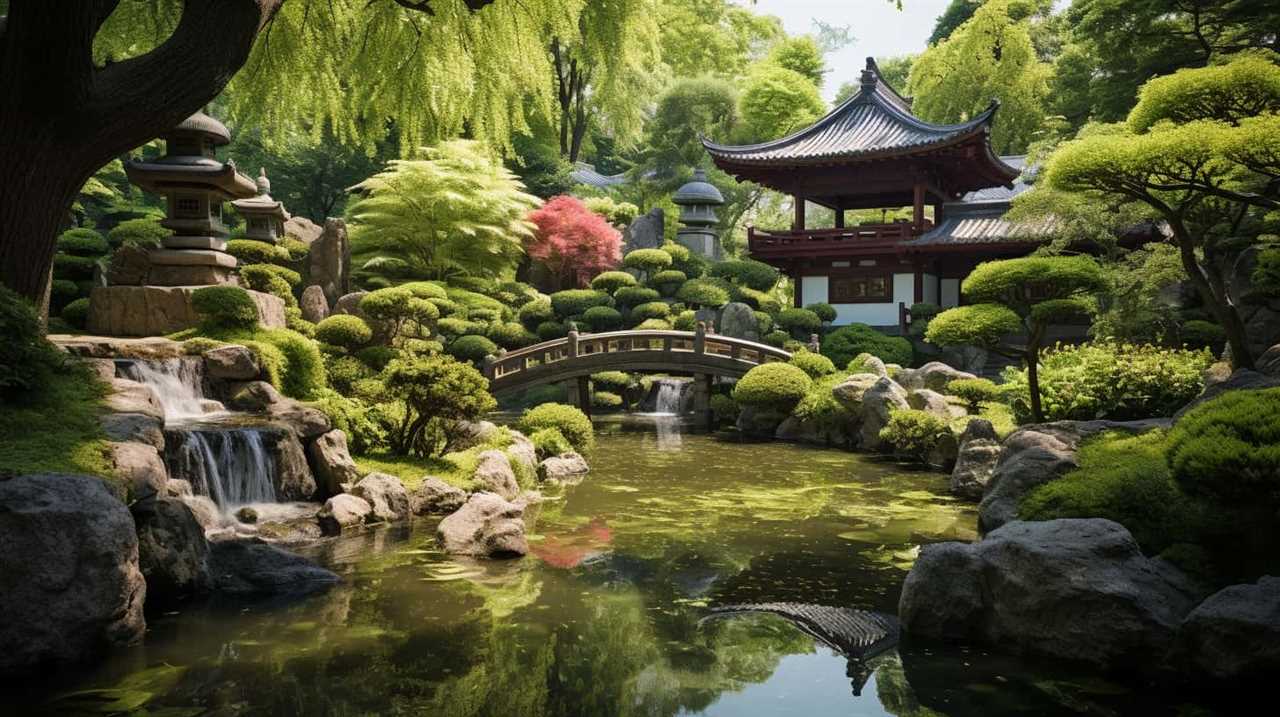
Whether you prefer the creamy sweetness of ice cream or the invigorating sip of a matcha latte, matcha-infused desserts are sure to satisfy your sweet cravings.
Now, let’s explore the fascinating world of traditional matcha ceremonies.
Exploring Traditional Matcha Ceremonies
Let’s delve into the rich cultural heritage of matcha by exploring traditional matcha ceremonies. These ceremonies have been an integral part of matcha tea history for centuries, embodying the elegance and mindfulness associated with Japanese tea culture.
Here are five key elements of traditional matcha ceremonies:
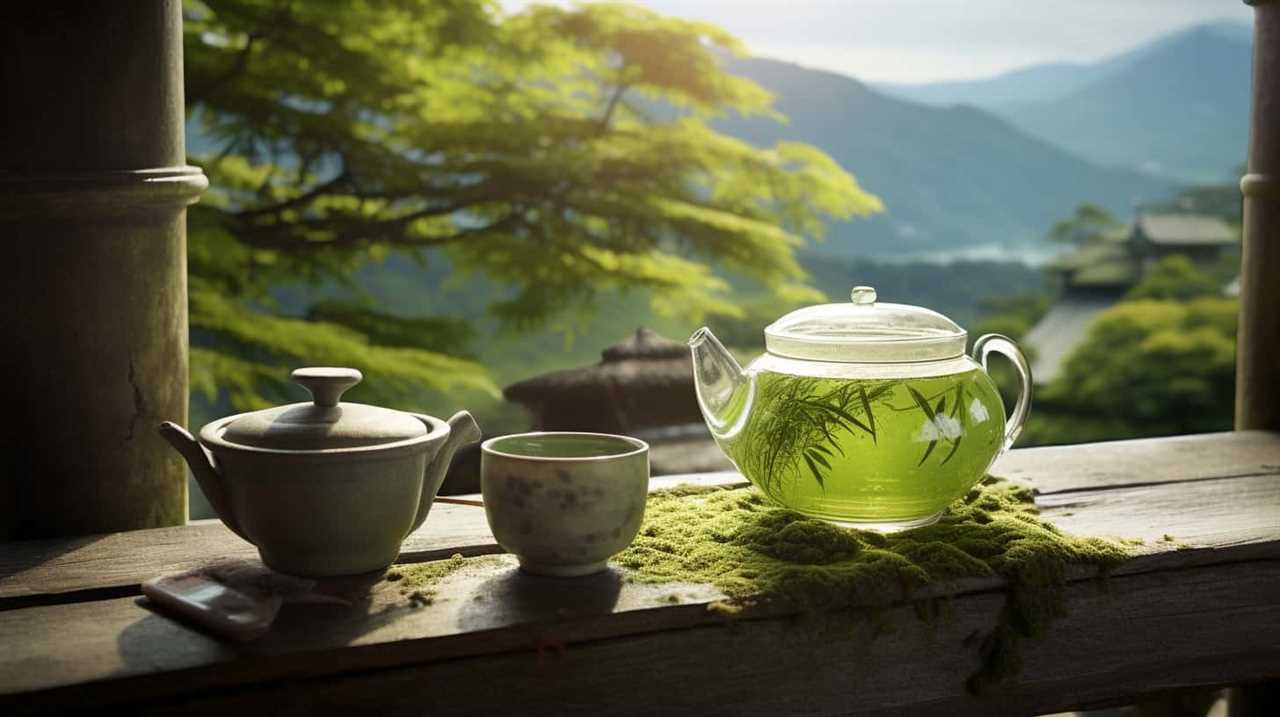
- Chashitsu: A dedicated tea room where the ceremony takes place, designed to create a serene and peaceful atmosphere.
- Chawan: A handcrafted bowl used to whisk matcha, often made from ceramic or porcelain, chosen for its texture and aesthetic appeal.
- Chasen: A bamboo whisk used to create a frothy and smooth matcha by whisking the tea powder and hot water together.
- Chakin: A small white linen cloth used to wipe the chawan and chasen, symbolizing cleanliness and purity.
- Zen Buddhism Influence: Traditional matcha ceremonies are deeply rooted in Zen Buddhism, emphasizing mindfulness, simplicity, and the appreciation of the present moment.
Frequently Asked Questions
How Many Calories Are There in a Serving of Matcha?
In a serving of matcha, there are approximately 3 calories. However, the health benefits of matcha go beyond just its low calorie count. It is packed with antioxidants and can boost metabolism and improve focus.
Can Matcha Help With Weight Loss?
Yes, matcha can help with weight loss. Its weight loss benefits come from its high levels of antioxidants and catechins, which boost metabolism and aid in burning fat. Incorporating matcha into your diet can support your weight loss goals.
Is Matcha Suitable for People With Caffeine Sensitivity?
Matcha alternatives are available for people with caffeine sensitivity. While matcha contains caffeine, its health benefits, such as antioxidants and increased metabolism, make it a popular choice. However, those with sensitivity can opt for decaffeinated versions or herbal teas.
Can Matcha Be Used as a Natural Food Coloring in Baking?
Yes, matcha can be used as a natural food coloring in baking. Its vibrant green hue adds a beautiful touch to cakes, cookies, and other sweet treats. Additionally, matcha can be incorporated into savory dishes for a unique and flavorful twist.
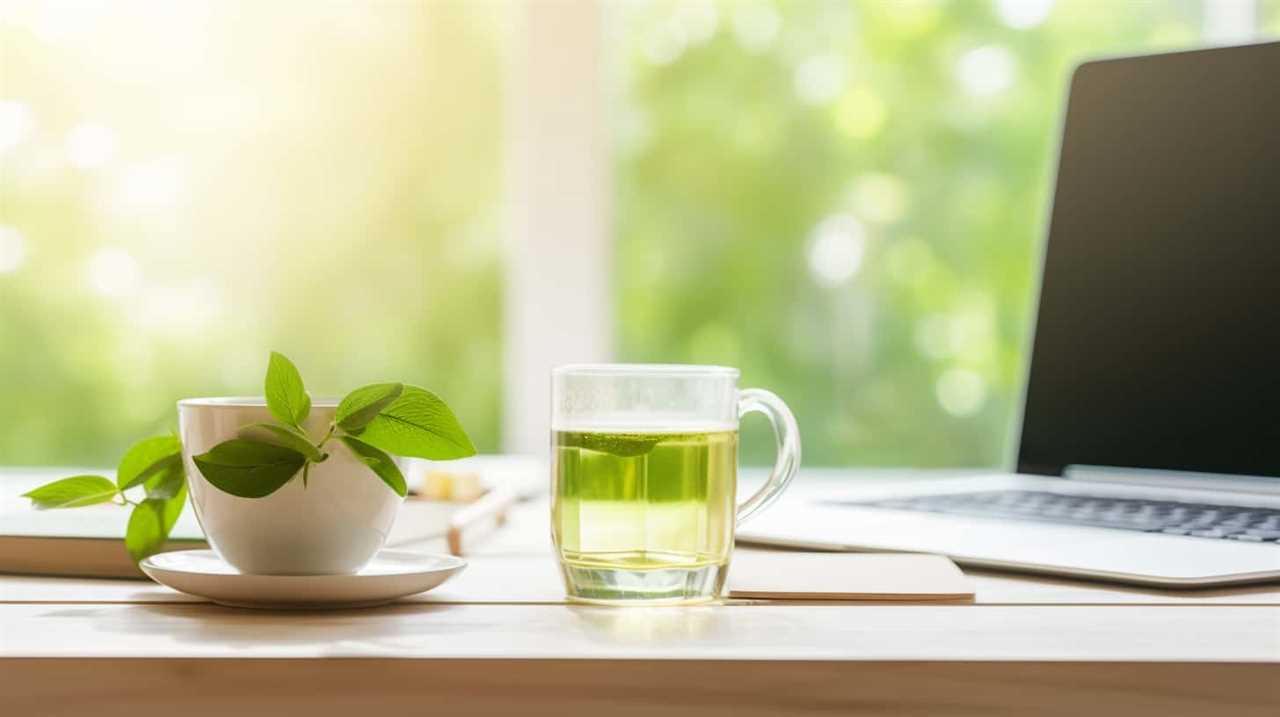
Are There Any Potential Side Effects of Consuming Matcha?
We’ve looked into the potential side effects of consuming matcha, and it’s important to note that when consumed in moderation, matcha offers numerous potential health benefits. As for daily consumption, it’s recommended to limit it to 1-2 cups.
Conclusion
In the world of matcha, there’s something for everyone. From the health benefits to the variety of recipes, green tea enthusiasts can indulge in delightful creations.
Whether you prefer a simple matcha latte, a refreshing smoothie, or even a savory dish, matcha can be enjoyed in countless ways.
And let’s not forget about the sweet tooth – matcha-infused desserts are a true delight.
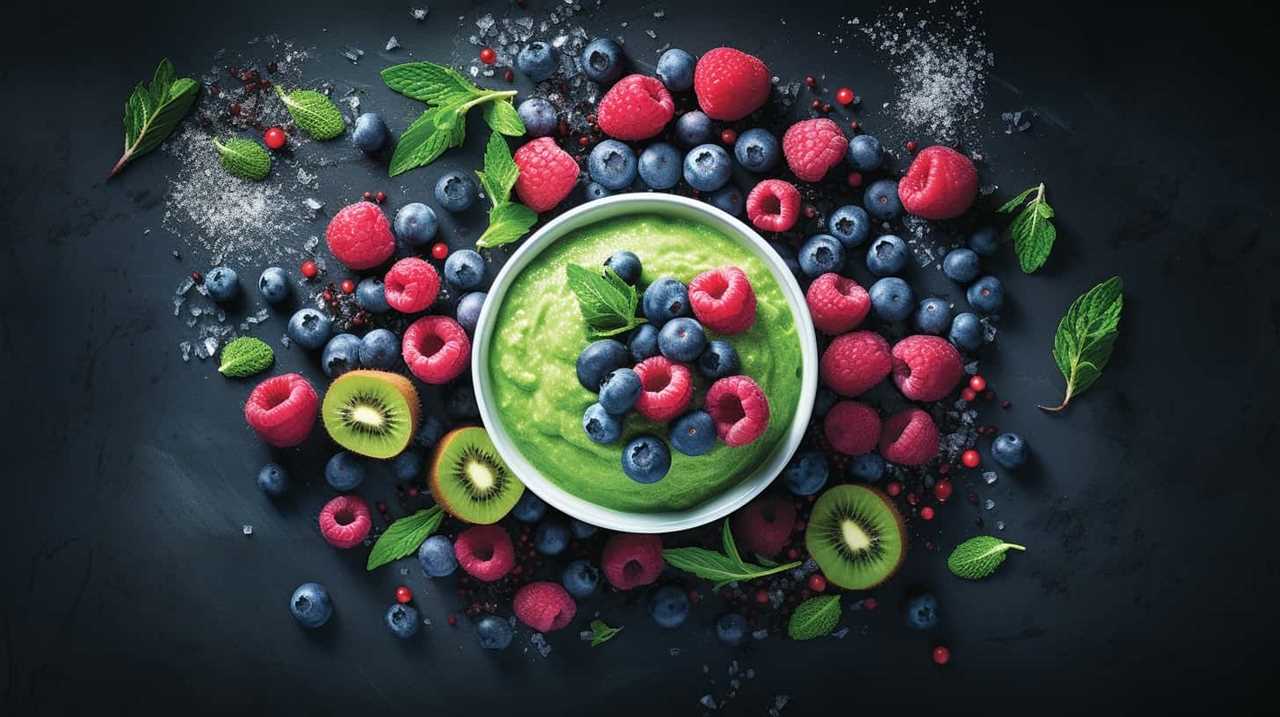
So go ahead, explore the world of matcha and let its vibrant flavors and rich traditions take you on a journey of culinary bliss.
Justin is a seasoned author, coffee and tea enthusiast, and an essential member of the Cappuccino Oracle team. With a keen appreciation for the complexities of coffee, coffee alternatives, and tea, Justin has dedicated his professional career to exploring these realms and sharing his insights with readers worldwide.
Justin’s immersion in the world of coffee, coffee alternatives, and tea began at a young age, kindling a passion that extended beyond mere consumption. This love for these beverages led him to combine his talent for writing with his devotion to coffee and tea, bringing him to Cappuccino Oracle as a dedicated author.
Matcha
Unveiling The Mysteries Of Matcha: Insights On Its Origins, Production, And Quality

Have you ever been curious about the mysteries behind the rich and natural flavors of matcha? If so, get ready to join me on an adventure as we uncover the secrets of matcha, delving into its origins, production, and quality.
As a lover of all things tea, I have delved deep into the world of matcha, immersing myself in its rich history and intricate production process. From the shade-grown tea leaves to the meticulous grinding technique, every step is a labor of love that culminates in the velvety smooth powder we know as matcha.
Join me as we unravel the secrets behind this ancient Japanese tradition and discover why quality is key when indulging in this verdant elixir. We’ll explore the nuances of flavor, the importance of sourcing, and even delve into the fascinating world of other tea varieties.
So grab a cup, sit back, and let’s dive into the captivating world of matcha.
Key Takeaways
- Matcha tea is made from powdered green tea leaves and has a long and labor-intensive production process.
- Premium matcha is made from the first harvest in early spring, using the top 3 sprouts of the tea plant and ground tencha leaves.
- Cheaper matchas may skip some steps in the production process and are more suitable for matcha lattes.
- High-quality matcha is recommended for sparing consumption, as it has a smoother flavor and more health benefits compared to cheaper matchas.
What is matcha?
I’ve learned that matcha is a powdered green tea made from special tea leaves that are shaded before harvest, and it has a long and labor-intensive production process.
There are different types of matcha available, but the premium matcha is made from the first harvest in early spring, using only the top 3 sprouts of the tea plant. The leaves are then steamed, dried, and have their stems removed before being ground into a fine powder using a specialized mill made of granite.
It’s important to note that high-quality matcha is recommended for sparing consumption, as it has a complex production process that results in a smooth flavor. Matcha also offers various health benefits, such as being rich in antioxidants, boosting metabolism, and improving mental alertness.
Production process
The matcha production process involves shading the tea leaves before harvest and selecting the top three sprouts of the tea plant for premium matcha. Shading is a technique used to enhance the flavor and quality of the tea leaves. By covering the tea plants with shade, the leaves produce more chlorophyll and amino acids, resulting in a vibrant green color and a rich, umami taste.
After the shading period, only the top three sprouts of the tea plant are carefully handpicked for premium matcha. These selected leaves, known as tencha leaves, are then steamed, dried, and have their stems removed.
Finally, the tencha leaves are ground into a fine powder using a specialized granite mill. This process results in the smooth and concentrated matcha powder that we enjoy.
Quality and consumption
Let me tell you, indulging in high-quality matcha is like sipping a vibrant green elixir that awakens your taste buds and nourishes your body with its rich flavor and numerous health benefits. Matcha’s health benefits are truly remarkable. Packed with antioxidants, vitamins, and minerals, matcha is known to boost metabolism, enhance focus and concentration, and strengthen the immune system.
But not all matcha is created equal. Different grades of matcha exist, ranging from ceremonial grade to culinary grade. Ceremonial grade matcha is made from the highest quality tencha leaves and has a smooth, vibrant green color and a delicate, umami flavor. It is best enjoyed on its own, whisked with hot water.
On the other hand, culinary grade matcha is more affordable and is suitable for making matcha lattes, smoothies, and baked goods. Although it may have a slightly bitter taste and a duller color, it still provides health benefits.
So, whether you choose to indulge in high-quality ceremonial grade matcha or opt for the more affordable culinary grade, incorporating matcha into your routine is a delicious way to reap its health benefits.
Frequently Asked Questions
What are some popular ways to enjoy matcha besides drinking it as tea?
Besides drinking matcha as tea, some popular ways to enjoy it include indulging in matcha desserts like matcha ice cream, matcha cake, and matcha cookies. Additionally, matcha smoothies are a refreshing and healthy option.
Are there any specific health benefits associated with consuming matcha?
I’m no expert, but matcha is said to have potential health benefits. Some claim it can aid in weight loss due to its high antioxidant content and metabolism-boosting properties. However, more research is needed to confirm these claims.
How does the quality of matcha affect its flavor and overall experience?
The quality of matcha directly affects its flavor and overall experience. Higher quality matcha, made from carefully selected leaves and processed with precision, offers a smoother and more vibrant flavor, while lower quality matcha may have a less appealing taste and color.
Can matcha be used in cooking or baking?
"Where there’s matcha, there’s a way! Matcha can be used in a variety of cooking and baking recipes, adding a vibrant green color and a unique earthy flavor to dishes like matcha desserts."
Are there any specific tips or techniques for properly preparing matcha tea at home?
To properly prepare matcha tea at home, start by sifting the matcha powder to remove any clumps. Then, choose water at around 175°F to 180°F for the best flavor. Gradually add water to the matcha and whisk in a "W" or "M" motion until frothy. Enjoy!
Conclusion
In conclusion, matcha tea is not just a beverage, but a rich and fascinating tradition that has evolved over centuries.
From its origins in Japan to its intricate production process, matcha is a labor of love.
The quality of matcha is crucial, as the steps taken in its production directly impact its flavor and aroma.
Whether you’re a matcha connoisseur or a beginner, there is a matcha tea out there for you.
So, why not indulge in a cup of this vibrant green elixir and experience the magic of matcha for yourself? It’s a journey worth embarking on!
Arf, an author and an innovative enthusiast of coffee, coffee alternatives, and tea, plays a crucial role as a contributor to the esteemed Cappuccino Oracle platform. Renowned for his curiosity and passion for these captivating beverages, Arf has carved out a unique space for himself in the world of exploration and writing. He realized that coffee, coffee alternatives, and tea are not mere drinks to keep one awake, but universes of flavors and stories waiting to be explored.
Arf’s articles for Cappuccino Oracle blend meticulous research with personal experiences, providing readers with an in-depth understanding of various types of coffee, coffee alternatives, and tea, along with their unique characteristics, cultures, and histories. His honest reviews and engaging narratives guide readers on their own journeys, helping them discover their preferences and find their perfect brew.
Matcha
Unveiling The Truth Behind Starbucks’ Matcha: A Disappointing Blend

Being a lover of tea, I was eager to sample Starbucks’ matcha beverages, anticipating a flavorful and genuine taste. However, to my dismay, I found that it was a subpar mixture of inexpensive green tea powder and an excessive amount of sugar. This was a stark contrast to the customary matcha experience that I had grown accustomed to.
The use of low-quality matcha by Starbucks is driven by the need for mass production and a consistent taste across all locations. But in this pursuit, they have sacrificed the true essence of matcha. Authentic matcha production involves meticulous steps to ensure a high-quality and flavorful product, steps that Starbucks seems to skip.
The result is a matcha latte packed with 32 grams of sugar, equivalent to a can of soda, and a whopping 240 calories. It’s time to unveil the truth behind Starbucks’ matcha and explore better options for a truly satisfying tea experience.
Key Takeaways
- Starbucks uses a cheap green tea powder for their matcha drinks, which may not even be considered matcha.
- The cheap matcha powder is mixed with a lot of sugar, negating the health benefits and undermining the quality of the tea.
- Starbucks’ matcha latte contains a high amount of sugar, similar to a can of soda, and has a significant number of calories.
- To have a better matcha experience, it is recommended to explore premium, first harvest matcha made by talented farmers in Japan and to try different matcha options to find preferred taste.
What is Starbucks Matcha?
Starbucks Matcha is a cheap green tea powder mixed with a high amount of sugar, which not only undermines the health benefits of matcha but also fails to deliver the natural, great-tasting flavor of authentic matcha tea.
The ingredients used in Starbucks matcha include low-quality green tea powder that is likely produced on a large scale. Unlike traditional matcha production methods, Starbucks skips certain steps to save time and money. These steps, such as shading the tea plants to reduce bitterness and selecting the top leaves for their flavor and nutrients, are crucial in creating high-quality matcha.
Instead, Starbucks opts for a blend of cheap green tea powder mixed with sugar, resulting in a dull and bitter flavor. This disappointing blend of ingredients does not live up to the standards of true matcha tea.
Quality vs. Cheap Matcha
Indulging in high-quality matcha is like savoring a delicate melody that dances on your taste buds, while settling for cheap matcha is akin to a discordant symphony that leaves a bitter aftertaste. When it comes to matcha, quality matters. Traditional matcha production is an art that requires time, patience, and attention to detail. The importance of shading the tea plants, selecting the top leaves, and using a stone mill to grind the leaves into a fine powder cannot be overstated. These steps not only enhance the flavor but also preserve the health benefits of matcha. High-quality matcha is rich in antioxidants, boosts metabolism, and promotes a sense of calm. On the other hand, cheap matcha often lacks these qualities as it skips crucial steps and is mixed with sugar and other additives. Don’t settle for a subpar matcha experience; choose high-quality matcha for its exceptional taste and health benefits.
| Traditional Matcha Production |
|---|
| Shading the tea plants |
| Selecting the top leaves |
| Grinding with a stone mill |
The importance of traditional matcha production cannot be overstated. These steps not only enhance the flavor but also preserve the health benefits of matcha. High-quality matcha is rich in antioxidants, boosts metabolism, and promotes a sense of calm. On the other hand, cheap matcha often lacks these qualities as it skips crucial steps and is mixed with sugar and other additives. Don’t settle for a subpar matcha experience; choose high-quality matcha for its exceptional taste and health benefits.
Recommendations for Better Matcha
Exploring different matcha options can lead to a better matcha experience. When it comes to matcha, not all options are created equal. While Starbucks may offer a convenient matcha latte, there are alternative options that provide a more authentic and higher quality experience.
Premium matcha, specifically first harvest matcha, is made by talented farmers in Japan and can be enjoyed plain, without the need for excessive sugar or additives. By choosing premium matcha, you can reap the full benefits that matcha has to offer, such as its high antioxidant content and potential health benefits.
Additionally, exploring different types of matcha, such as Japanese black tea, can expand your taste palate and introduce you to new and exciting flavors. So, why settle for a disappointing blend when there are better matcha options out there waiting to be explored?
Frequently Asked Questions
How is Starbucks matcha different from traditional matcha?
Starbucks matcha differs from traditional matcha in terms of quality and taste. One interesting statistic is that Starbucks’ matcha latte contains 32 grams of sugar, similar to a can of soda, which undermines the health benefits of matcha.
What are the health benefits of matcha and how do they differ between Starbucks matcha and premium matcha?
The health benefits of matcha include high levels of antioxidants, increased energy, and improved focus. However, Starbucks matcha quality is compromised due to the use of cheap powder mixed with sugar, negating these benefits.
Can you customize the sweetness level of Starbucks matcha drinks?
Yes, you can customize the sweetness level of Starbucks matcha drinks. They offer popular matcha drink variations like matcha latte and matcha frappuccino, allowing customers to choose the amount of sweetener they prefer.
Are there any alternative options for matcha drinks at Starbucks?
Yes, there are alternative options for matcha drinks at Starbucks. However, it’s important to note that the taste may not be comparable to traditional matcha. Exploring different matcha options and Japanese black tea can provide a better experience.
What are the steps involved in producing high-quality matcha and how does Starbucks’ matcha production differ?
Starbucks’ matcha production process differs from traditional matcha production in Japan. High-quality matcha involves shading the tea plants, selecting the top leaves, steaming, drying, and grinding them. However, Starbucks skips these steps, resulting in a lower quality and less authentic matcha experience.
Conclusion
In conclusion, after delving into the truth behind Starbucks’ matcha, it’s clear that their blend falls short of expectations. The use of cheap green tea powder mixed with excessive sugar dilutes any potential health benefits and fails to deliver an authentic matcha experience.
To truly enjoy the rich and flavorful taste of matcha, it’s recommended to explore premium, first harvest options crafted by skilled Japanese farmers. Don’t settle for subpar matcha; treat yourself to a tea experience that’ll leave your taste buds dancing with delight.
Arf, an author and an innovative enthusiast of coffee, coffee alternatives, and tea, plays a crucial role as a contributor to the esteemed Cappuccino Oracle platform. Renowned for his curiosity and passion for these captivating beverages, Arf has carved out a unique space for himself in the world of exploration and writing. He realized that coffee, coffee alternatives, and tea are not mere drinks to keep one awake, but universes of flavors and stories waiting to be explored.
Arf’s articles for Cappuccino Oracle blend meticulous research with personal experiences, providing readers with an in-depth understanding of various types of coffee, coffee alternatives, and tea, along with their unique characteristics, cultures, and histories. His honest reviews and engaging narratives guide readers on their own journeys, helping them discover their preferences and find their perfect brew.
Matcha
The Ultimate Guide To Using Chashaku: Your Matcha Essential

Being a lover of matcha, I am aware that the crucial factor in achieving the perfect matcha bowl is the equipment we utilize. When it comes to preparing matcha, there is one tool that is particularly essential: the chashaku.
This bamboo spoon, with its elegant design and precise measurements, is the secret weapon of matcha lovers worldwide. In this ultimate guide, I will take you on a journey through the history and evolution of the chashaku, and show you how to use it like a pro.
From its origins as a metal or ivory scoop to its modern-day incarnation in bamboo, the chashaku has come a long way. With its 48° bend and 18mm length, it effortlessly scoops the perfect amount of matcha from its container.
So grab your chashaku and get ready to elevate your matcha game to new heights. Let’s dive in and discover the wonders of this matcha essential.
Key Takeaways
- Chashaku is a bamboo spoon used to scoop matcha powder in the Japanese tea ceremony and by matcha lovers worldwide.
- Chashaku is one of the three important tea utensils used in the tea ceremony and is about 18mm in length with a 48° bend at the end for scooping.
- Chashaku is made of bamboo to avoid negative reactions with matcha powder and is a great measurement tool for matcha powder.
- Two scoops of chashaku is the standard amount for a bowl of matcha tea, and it is easy to maneuver in matcha tins or natsume due to its small size.
What is Chashaku?
Chashaku is a bamboo spoon used to scoop matcha powder, and it’s one of the three important tea utensils used in the Japanese tea ceremony.
Made from a single piece of bamboo, this elegant tool has a long history dating back to the Muromachi period in Japan. Originally crafted from metal or ivory, chashaku evolved to be made of bamboo due to its natural properties and to avoid any negative reactions with matcha powder.
The design of chashaku is both functional and beautiful, with a length of about 18mm and a 48° bend at the end for easy scooping. There are different styles of chashaku scoops, each with its own unique shape and characteristics. The back of the chashaku has a rough texture, while the face is smooth and sleek.
Whether you’re a matcha lover or a tea ceremony enthusiast, using a chashaku adds a touch of authenticity and tradition to your matcha preparation.
History and Evolution
During the Muromachi period in Japan, the chashaku spoon evolved from being made of metal or ivory to its current bamboo form, which is about 18mm in length and has a 48° bend at the end for easier scooping. The history and evolution of the chashaku is a testament to its significance in Japanese tea ceremonies and its cultural importance in matcha preparation.
| The significance of chashaku in Japanese tea ceremonies | The cultural importance of chashaku in matcha preparation |
|---|---|
| Chashaku is one of the three important tea utensils used in the tea ceremony. | Chashaku is a great measurement tool for matcha powder. |
| Chashaku originated in Japan during the Muromachi period. | Chashaku’s small size allows for easy maneuvering in matcha tins or natsume. |
| Originally made of metal or ivory, chashaku evolved to be made of bamboo. | Chashaku is made from a single piece of bamboo and shaped with a bend for the scoop. |
| Chashaku is made of bamboo to avoid negative reactions with matcha powder. | The back of chashaku has a rough texture, while the face is smooth and sleek. |
The chashaku’s role in Japanese tea ceremonies cannot be understated. It is one of the three essential utensils used in the tea ceremony, alongside the chawan (tea bowl) and chasen (tea whisk). The chashaku’s small size and precise measurement make it the perfect tool for scooping matcha powder. Its evolution from metal or ivory to bamboo shows the cultural importance placed on this utensil. The chashaku’s design, with its gentle bend and smooth face, allows for easy and graceful scooping of matcha. Using the chashaku is not only practical but also a way to honor the centuries-old tradition of matcha preparation.
How to Use Chashaku
To use the chashaku, I simply hold it like a pencil and dip the scoop into the matcha container. Then, I carefully lift the chashaku scoop out and place it over the matcha bowl to dump the powder.
It’s a simple and elegant technique that ensures the perfect amount of matcha every time.
But did you know that there are alternative ways to use the chashaku? Some matcha lovers prefer to use a teaspoon or a regular spoon to scoop their matcha powder. While these alternatives may work in a pinch, they don’t offer the same precision and authenticity as the chashaku.
The chashaku’s unique design and size make it the ideal tool for measuring matcha powder. Plus, using the chashaku adds a traditional touch to the matcha preparation process, enhancing the overall experience.
So why settle for anything less? Embrace the chashaku and elevate your matcha game to the next level.
Frequently Asked Questions
What are the different types of materials used to make chashaku besides bamboo?
There’s something truly magical about the chashaku, the bamboo spoon that gracefully scoops matcha powder. While bamboo is the traditional material, chashaku can also be made from metal or ivory, although these alternatives are less common.
Can chashaku be used to scoop other powders besides matcha?
Yes, chashaku can be used to scoop other powders besides matcha. However, it is primarily designed for scooping matcha powder and is most commonly used in Japanese tea ceremonies. To properly clean and care for a chashaku, it is recommended to wipe it with a dry towel or tissue to avoid water damage. The chashaku is a versatile tool with different uses in the tea ceremony, making it an essential item for matcha lovers.
How long does a chashaku typically last before it needs to be replaced?
A chashaku typically lasts for a long time, but the lifespan can vary depending on the material. Bamboo chashaku is the most common and durable option, while metal or ivory may wear down over time. Proper care involves cleaning with a dry towel or tissue to avoid water damage.
Can chashaku be used with different types of matcha bowls or is it specific to a certain style?
Absolutely! Chashaku can be used with various types of matcha bowls, adapting to different styles. Its small size and unique design make it perfect for scooping matcha powder and adding a touch of elegance to your matcha preparation.
Are there any alternative utensils that can be used in place of chashaku for scooping matcha powder?
Yes, there are alternative utensils for scooping matcha powder, such as a teaspoon or a small spoon. However, using a chashaku has its benefits. Its unique design allows for precise measurements and easy maneuvering in matcha tins.
Conclusion
In conclusion, using chashaku isn’t just a practical way to measure and scoop matcha powder, but it’s also an essential tool for embracing the art and tradition of the Japanese tea ceremony.
While some may argue that using a regular spoon can achieve the same result, chashaku offers a unique experience that connects us to centuries of tea culture. Imagine holding the slender bamboo spoon, feeling the weight of tradition in your hand, and delicately scooping the vibrant green matcha powder.
It’s a sensory journey that brings us closer to the beauty and mindfulness of matcha preparation. So, embrace the chashaku, and let it elevate your matcha experience to new heights.
Arf, an author and an innovative enthusiast of coffee, coffee alternatives, and tea, plays a crucial role as a contributor to the esteemed Cappuccino Oracle platform. Renowned for his curiosity and passion for these captivating beverages, Arf has carved out a unique space for himself in the world of exploration and writing. He realized that coffee, coffee alternatives, and tea are not mere drinks to keep one awake, but universes of flavors and stories waiting to be explored.
Arf’s articles for Cappuccino Oracle blend meticulous research with personal experiences, providing readers with an in-depth understanding of various types of coffee, coffee alternatives, and tea, along with their unique characteristics, cultures, and histories. His honest reviews and engaging narratives guide readers on their own journeys, helping them discover their preferences and find their perfect brew.
-

 Americano4 weeks ago
Americano4 weeks agoHow to Make Americano With Moka Pot
-

 Americano2 weeks ago
Americano2 weeks agoHow to Make Korean Iced Americano
-

 Americano4 weeks ago
Americano4 weeks agoHow to Make Iced Americano With Instant Coffee
-

 Americano4 weeks ago
Americano4 weeks agoHow to Make Americano With Bialetti
-

 Americano4 weeks ago
Americano4 weeks agoHow to Make Dutch Bros Americano
-

 Americano6 days ago
Americano6 days agoHow to Make an Iced Americano With Nespresso
-

 Americano2 weeks ago
Americano2 weeks agoHow Many Shots of Espresso for 16 Oz Americano
-

 Turmeric Tea1 week ago
Turmeric Tea1 week agoTurmeric Saffron Tea

















